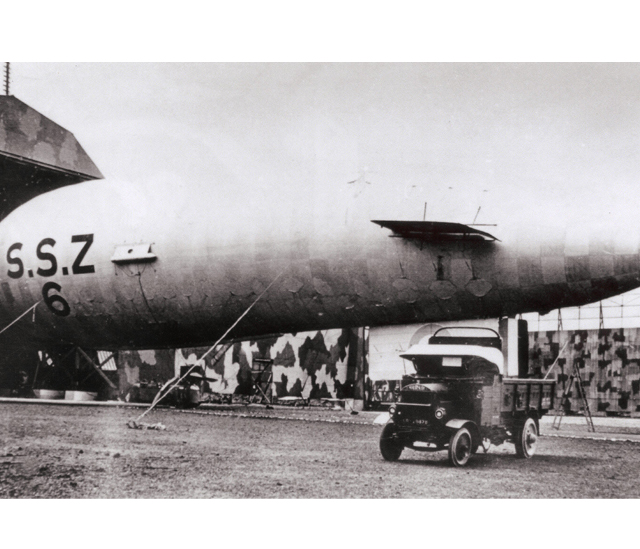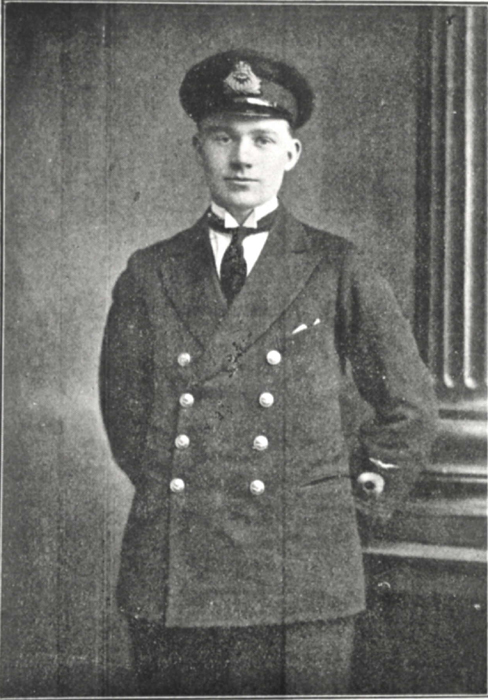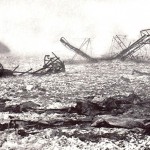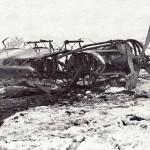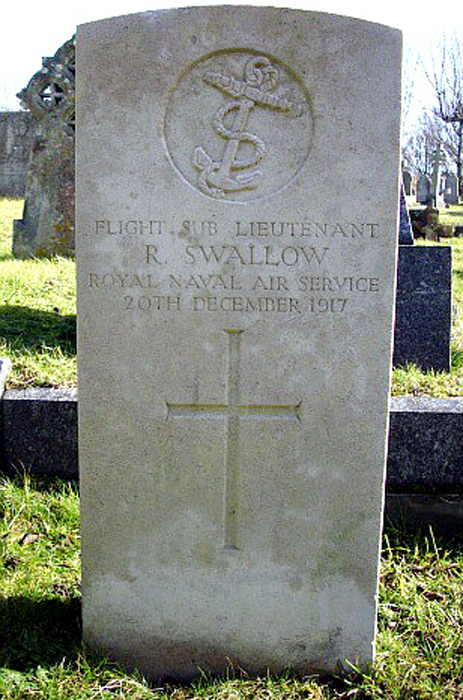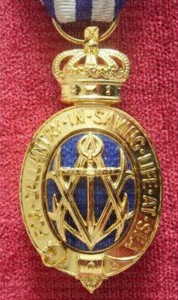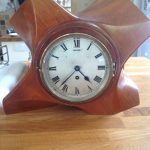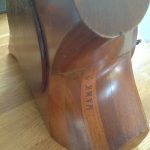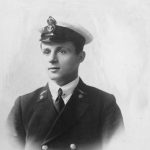During the First World War, hydrogen filled airships patrolled the air and coastline around Britain. This duty was, however, not without some serious risks.
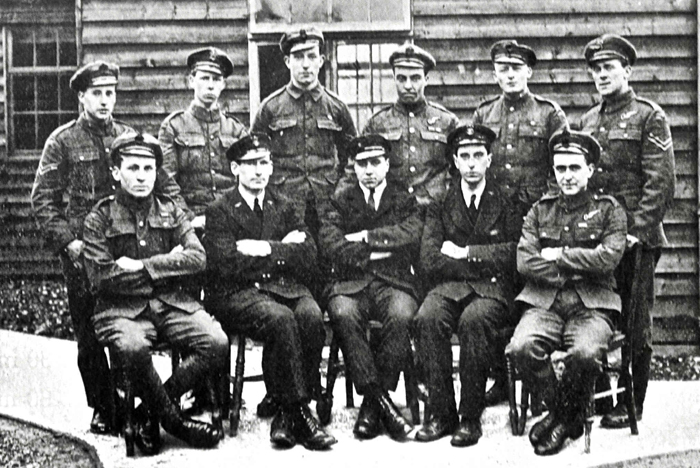
Honours Group Polegate RNAS – Steere seated 1st left, 2c Dodd standing 2nd left, 2c Robinson standing 4th left – Image courtesy of Rosalind Hodge
On the morning of 20 December 1917 five airships set out early on a routine patrol of the Channel from the Polegate Royal Naval Airship Station at Willingdon. The weather was clear although very cold with snow lying on the ground. Low cloud drifted in from the northeast around mid-day. By 3 pm the crews were recalled directly to base as thick fog had rapidly developed over the Channel and coastal area. They circled above the station attempting to find an area for landing but conditions prevented this and the pilots were forced to search safe mooring in open country. All found suitable sites and radioed for ground parties to be sent out to secure their ships until conditions allowed them to return to base. The ships were the Submarine Scout Zero (S.S.Z) class. Two ships S.S.Z7 and Z19 moored near the Beachy Head coastguard station around 8.30 pm and the three others further inland: Z6 landed just north of Hailsham whilst Z9 and Z10 landed on the Downs at Willingdon Hill Farm on the Willingdon, Jevington border. During the evening a strong wind sprang up from the east. Back at the station there was concern that if this increased to gale force, the vessels at Beachy Head could not be held by the ground crew. The pilots were therefore instructed to return to base as soon as possible.
The night was dark with sleet and snow flurries but the wind had partially dispersed the low cloud as the two ships started homeward. Z19 was the first to leave making it safely back to base. As soon as it had disappeared into the darkness Z7 took off. The captain Flight Sub Lt. Richard Swallow, flew northwards passing the village of East Dean, flying fairly close to the ground following the valley which ran through the Downs past Jevington towards Wannock. His observer wireless operator, Victor Dodd, leant over the coaming at the front of the car shining his Aldis lamp down ahead of the ship. Peering into the blackness at the vague shapes of trees and hedges below, he hoped to make out some recognisable features.
Victor Dodd described how an airship suddenly appeared in the light beam of his Aldis lamp immediately ahead. It was impossible to tell whether the other ship was in the air or on the ground, but it was obvious that a collision would occur unless evasive action was taken. Dodd shouted out a warning to Lt. Swallow who instantly applied the elevator and opened up the engine – but it was too late. They skimmed the top of the other vessel, Z10, ripping open its gasbag causing the hydrogen to rush out. Ignited by the flame from Z7s exhaust, a sheet of blazing gas leapt into the night sky and caught the stern of Lt. Swallow’s vessel. The fabric-covered fin and rudder burst into flames, the fire quickly spreading to the envelope.
Dodd shouted “well afire aft” and captain Swallow shouted back “All for yourselves boys”. Dodd recounted in a tape recording how there were two 65-lb bombs above him in racks, a box of Very lights was stacked behind his neck and he was surrounded by double-decker pans of Lewis gun ammunition, ninety-six rounds per pan. He instantly decided to take his chance and climbed out of the cockpit over the side of the car. Lowering himself down until he was hanging at arms length, he dropped into the darkness away from the roaring flames above his head not knowing how far below the ground was. At the same moment Air Mechanic Hughes, the engineer seated at the rear of the car, jumped over the side. The two men dropped close to each other, falling onto the snow-covered grass. Both received severe internal injuries as well as many broken bones.
Without the weight of these two crew in the car Z7, burning from end to end, rose in the air to a height of 2 – 300 feet. Then, crumpling, fell, blazing into a field of gorse a short distance from the point of collision. Lt. Swallow, who stayed with his ship trying to regain control, died in the flaming wreckage.
- Wreckage of S.S.Z10 beside Willingdon Hill Farm Dec 1917 – Image courtesy of Rosalind Hodges
- Wreckage of airship S.S.Z7 on Willingdon Hill 1917 – Image courtesy of Rosalind Hodges
The ship crashed not far from where Dodd and Hughes lay, badly injured and half conscious. Two men from the ground party ran across the snowy field to the blazing wreck. Finding two crew members close to the wreckage, still alive but unable to move, Air Mechanic Robinson and Boy Mechanic Steere detached the now almost red hot bombs from the bomb racks of the burning ship. The bombs were liable to explode at any time, as they carried them a safe distance away from the crash site and their injured colleagues. At the same time, twenty year old Flying Officer Lt. Victor Albert Watson, thinking there was still a member of the crew in the blazing Z10 car, rushed without hesitation to investigate, despite there also being bombs on board liable to explode at any moment in the fierce heat. Fortunately he found no crew but as he turned away a bomb exploded badly injuring him with shrapnel
Some of the men used a five bar gate as a stretcher to carry the injured crew to the nearby farm. They were transferred to the Military hospital at Eastbourne, a difficult journey across snow-covered fields. Dodd suffered two broken wrists, broken legs and pelvis. Hughes suffered spinal injuries and broken legs. Following many months in hospital Dodd and Hughes recovered from their injuries and resumed to service. Victor Dodd returned to Polegate and being unable to continue flying as a result of his injuries, he transferred to ground maintenance duties on the station’s wireless equipment and airships for the duration of the war. Victor Albert Watson lost his right arm but returned to Polegate and was promoted to Captain and Senior Flying Officer at the station in June 1918.
The pilot of the Z7, Flight Sub Lt Richard Swallow, aged 26, was buried on Christmas Eve at Ockynge Cemetery Eastbourne, perhaps strangely not in Willingdon churchyard, the parish in which he was stationed and had died. That Christmas was a sad one for the shocked personnel of the Polegate airship station with any thoughts of the usual festivities marred by the tragic accident.
For their acts of heroism, the King presented the three men with the following honours at Buckingham Palace as announced in The London Gazette
Flight Lieutenant Victor WATSON RN, Air Mechanic Harold ROBINSON, Boy Mechanic Eric STEERE, Naval airship fires
The London Gazette 8 March 1918 (from Whitehall, March 6, 1918)
The KING has been pleased to award the Albert Medal to Flight Lieutenant Victor Albert Watson, R.N., and the Albert Medal in Gold to Air Mechanic, 1st Grade, Harold Victor Robinson and Boy Mechanic Eric Edward Steere, in recognition of their heroic conduct in the following circumstances:
On the occasion of an accident to one of His Majesty’s Airships, which resulted in a fire breaking out on board her, Flight Lieutenant Watson, who was the senior Officer on the spot, immediately rushed up to the car of the airship under the impression that one of the crew was still in it, although he was well aware that there were heavy bombs attached to the airship which it was impossible to remove owing to the nearness of the fire, and which were almost certain to explode at any moment on account of the heat. Having satisfied himself that there was in fact no one in the car, he turned away to render assistance elsewhere, and at that moment one of the bombs exploded, a portion of it shattering Lieutenant Watson’s right arm at the elbow. The arm had to be amputated almost immediately.
Air Mechanic H. V. Robinson and Boy Mechanic E. E. Steere, on the occasion of an accident to one of His Majesty’s airships which caused a fire to break out on board her, approached the burning airship without hesitation, extricated the pilot and two members of the crew, all of whom were seriously injured, and then unclipped the bombs from the burning car and carried them out of reach of the fire. As the bombs were surrounded by flames, and were so hot that they scorched the men’s hands as they carried them, they must have expected the bombs to explode.
Flight Lieutenant Watson subsequently exchanged the Albert Medal for the George Cross.
Boy-mechanic Eric Steere was a Sussex boy, born in Worthing and was just 17 years old when this disaster occurred. He had tried to join the Royal Naval Air Service aged 16 following the death of his elder brother in the Royal Navy in 1915. He was so determined that he joined on his 17th birthday. Sent to Polegate he soon became proficient and made many flights from that base. After the war he worked on the enormous R38 ridged airship designed during the last months of the war by the Royal Navy. On 23 August 1921 whilst on a final test flight over the Humber at Hull, it broke it’s back, split in half exploding. Of the 49 British and Americans on board 44 were killed including Eric Steere who was then aged 21.
There is reason to believe that following the disaster, Hetty Swallow, widow of Richard, was presented with a memorial clock made from the propeller of the Z7 airship. She owned the clock for the rest of her life and kept it in her home in Gravesend, Kent. Following her death, the clock was passed onto her close friends the Hammond family, and it remains in their possession.
- Clock reportedly made from the propeller of Z7 – Image courtesy of John Hammond
- Clock reportedly made from the propeller of Z7 – Image courtesy of John Hammond
- Captain Flight Sub Lt Richard Swallow – Image courtesy of John Hammond
Victor Dodd OBE continued in aircraft communications for his entire career and on his retirement in 1964 was Deputy Director of the Air Ministry. He stayed in contact with his friend and colleague Hughes.
With thanks to the grandson of Victor Dodd for a recording made in 1968 of his memories of the Airship Station and this incident.
This story was submitted by Rosalind Hodge, Archivist, Willingdon Parish Church and then later updated on 5 August 2015 following additional information. This story was also updated on 28 March 2017, following information kindly provided by John Hammond.

